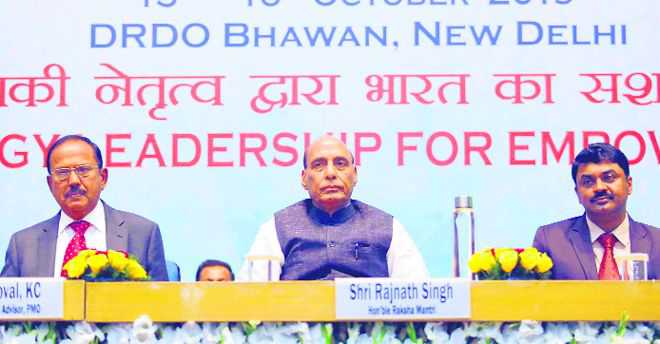
Make in India: Rajnath Singh (R) has stressed the need to reduce dependence on imported systems in critical defence technologies.
Air Marshal Brijesh Jayal (retd)
Defence Commentator
On the 88th birth anniversary of APJ Abdul Kalam, addressing the Defence Research and Development Organisation (DRDO) directors’ conference, Defence Minister Rajnath Singh lauded the former President’s contribution to science and missile technology. He urged the scientific community to follow Kalam’s work ethos, emphasising that the time was right to decrease our dependence on imported systems and become self-reliant in critical defence technologies.
A few days later, while addressing the Indian Defence and Aerospace Summit, the minister highlighted that the technological gap between the indigenous Light Combat Aircraft and the state-of-the-art Rafale had to be bridged if India wanted to be a competitive defence production player in the world. Commenting on our import dependence, he cautioned that a country like India, aspiring to be a global nation on a par with the top five global economies, cannot continue depending so heavily on defence imports from foreign players.
Clearly, the minister’s visit to France, where he received the first Rafale aircraft from Dassault Aviation and held discussions, and a message from China were playing on his mind. The latter was the military parade in Beijing earlier in the month, showcasing the continuing growth in China’s military and technological capabilities, chief amongst them being the remarkable advances made in the field of aerospace. On display were J-20 stealth fighters, fourth-generation J-16 and J-10C fighters, Y-20 heavy transport aircraft and the Z-20 transport helicopter amongst drones encompassing diverse roles of supersonic high-altitude reconnaissance and multi-role combat for precision attacks. This display of military and aerospace technology conveyed a clear political message to the international community, at a time of growing security concerns over China’s rise.
Interestingly, both the above-named gatherings also saw the active participation of the three service chiefs, along with officers concerned. Since it is the armed forces, more particularly the Army and the IAF, that have been at the receiving end of some of the problems that plague our indigenisation efforts, one had expected a frank appraisal from the user’s perspective of what is positive and what is lacking in the entire defence research and production ecosystem that has resulted in the existing state of import dependence.
The Chief of Army Staff (COAS) complimented strides made by the DRDO to meet service requirements through home-grown solutions and expressed confidence that “we will fight the next war through indigenised weapon systems and equipment” Yet, little was mentioned of why the country has to rely on Russian technology and licence production for the Army’s assault rifle.
The COAS said technology leadership defined the DRDO and that over seven decades, the organisation has been able to achieve objectives of self-reliance to a great extent. Again, little was said on the reasons why the ambitious Light Combat Aircraft is decades behind schedule but is yet to achieve full operational clearance and the IAF is likely to need foreign platforms for the foreseeable future.
According to media reports, at the IDAS (Indian Defence Accounts Service), the country’s three defence chiefs and the Ministry of Defence were on the same page — that Make-in-India should be a productive tool to achieve the objective of self-reliance. While due credit must be given to the many indigenisation successes, this needs to be tempered with an objective assessment of what ails the present system and how it needs to be restructured to successfully achieve the Make-in-India mission. This challenge is not unique to India. Those with successful defence industries have faced it and found answers while we appear to be in denial and content with ad hoc solutions.
Jacques Gansler, later the under secretary of defence for acquisition and technology in the Bill Clinton administration, was best known for his work on defence acquisition and procurement issues and how these processes could be used to serve the war-fighter and make the government more efficient. He believed that ‘in order to understand the economic operation of the US defence industry, it is first absolutely essential to recognise that there is no free market at work in this area and that there cannot be one because of the dominant role played by the federal government. The combination of a single buyer, a few large firms in each segment of the industry, and a small number of extremely expensive weapons programmes constitute a unique structure for doing business.’
This, in essence, sums up the challenge to governments, defence research institutions and industries across the globe — how to keep a unique structure for doing business finely balanced between free markets on the one hand and state control on the other.
If, indeed, the nation aspires to take its place in the forefront of defence technology and manufacturing, to become a force to reckon with in the international market, then it is the entire defence research and production system, both public and private, that must come under scrutiny to arrive at our own ‘unique structure for doing business.’
A proposed national aeronautics policy was submitted to the government by the Aeronautical Society of India (AeSI) in 1994. In its preamble, the then President of the AeSI, Kalam, had stated: “Aviation is one of the most significant technological influences of modern times and empowers the nation with strength for international partnership. It is a major tool for economic development and has a significant role in national security and international relations.”
Since this proposal elicited no response, in 2004, the AeSI resubmitted a revised proposal for an overarching national aeronautics policy, along with a proposed supporting organisation with a view to according aeronautics the status of a national mission to enable it to take its rightful place internationally. This proposal, too, remains stillborn.
It would indeed be a fitting tribute to Kalam if the Defence Minister can get the MoD to retrieve this proposal from the archives and open it for debate among various stakeholders. This would help reach India’s own ‘unique structure of doing business’ in the military and civil aeronautics field and indeed show the way for other high-technology defence systems and free us from the dubious record of being the second largest arms importer internationally.



























